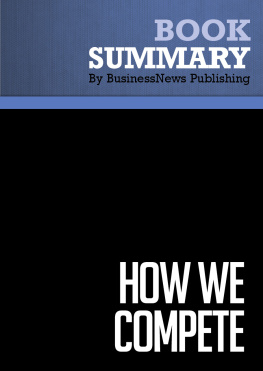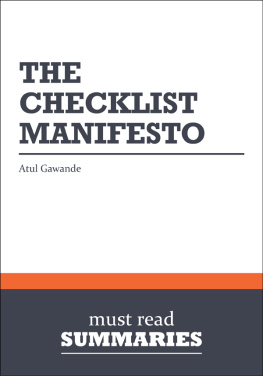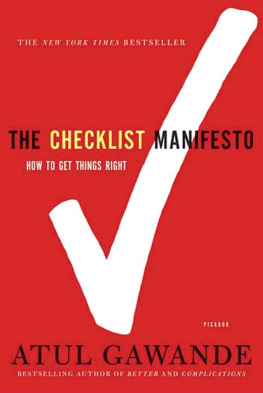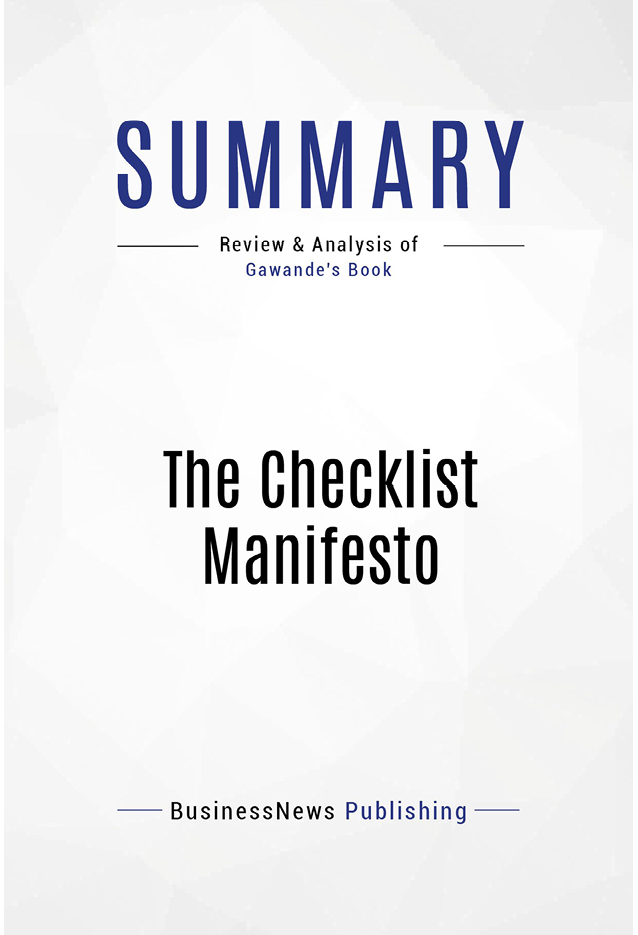Book Presentation:
The Checklist Manifesto by Atul Gawande
Book Abstract
MAIN IDEA
In complex situations such as those which arise in almost every profession and industry today the solutions to problems are technical and demanding. There are often a variety of different ways to solve a problem. Its all too easy to get so caught up dealing with all these complexities that the most obvious and common sense immediate solutions are not tried first. To overcome this problem, take a leaf from the commercial aviation industry and develop checklists people can use to make sure every base is covered quickly and concisely. Checklists are a forgotten or ignored business tool. Its time for them to come in from the cold.
Here, then, is our situation at the start of the twenty-first century: We have accumulated stupendous know-how. We have put it in the hands of some of the most highly trained, highly skilled, and hard-working people in our society. And with it, they have accomplished extraordinary things. Nonetheless, that know-how is often unmanageable. Avoidable failures are common and persistent, not to mention demoralizing and frustrating, across many fields from medicine to finance, business to government. And the reason is increasingly evident: the volume and complexity of what we know has exceeded our individual ability to deliver its benefits correctly, safely, or reliably. Knowledge has both saved us and burdened us. That means we need a different strategy for overcoming failure, one that builds on experience and takes advantage of the knowledge people have but somehow also makes up for our human inadequacies. And there is such a strategy- though it will seem almost ridiculous in its simplicity, maybe even crazy to those of us who have spent years carefully developing ever more advanced skills and technologies. It is a checklist.
Atul Gawande
About the Author
ATUL GAWANDE is a general surgeon in Boston, a staff writer for The New Yorker and an assistant professor at Harvard Medical School and the Harvard School of Public Health. He has written two other books, Better: A Surgeons Notes on Performance and Complications: A Surgeons Notes on an Imperfect Science.
The Web site for this book is at www.thechecklistmanifesto.com .
Important Note About This Ebook
This is a summary and not a critique or a review of the book. It does not offer judgment or opinion on the content of the book. This summary may not be organized chapter-wise but is an overview of the main ideas, viewpoints and arguments from the book as a whole. This means that the organization of this summary is not a representation of the book.
Summary of The Checklist Manifesto (Atul Gawande)
The Problem
Extreme complexity and specialization
Modern medical care is a good example of how professional fields of expertise have developed in recent years with the coming of the information revolution. Todays medical practitioners are extremely educated and superbly experienced in their areas of expertise, but that increase in specialization is bringing about some unintended consequences. Everyone is getting so busy in their respective areas of expertise some basic and preventable patients deaths are occurring.
Medical care in the twenty-first century is highly impressive. Saves are made daily of patients who just a few years ago would have faced certain death. For all those achievements, however, a surprising number of patients still die due to some very basic human errors:
- Medical machinery which has not been properly serviced and therefore which is not working when it is needed in an emergency setting.
- Teams that cant get moving fast enough in order to perform a needed procedure.
- Someone somewhere along the line forgets to wash their hands and an infection takes hold with fatal consequences.
The World Health Organization has estimated there are now more than thirteen thousand different diseases, syndromes and types of injury. For nearly all of them, science has provided things that can be done to help either by curing the disease or by reducing the harm and misery involved. The challenge is for each condition, the treatment steps are different and they are almost always complex. The average clinician has about six thousand drugs and around four thousand medical and surgical procedures to choose from. This is a lot for someone to get right, even someone who has been trained for many years.
On any given day in the United States, around ninety thousand people will be admitted to intensive care. That means over a year, some five million Americans will receive intensive care and almost everyone will get to see the inside of an intensive care unit over the course of their lifetime. According to one study, the average patient in intensive care will require 178 individual actions per day administering a drug at the right time, turning the patients regularly to avoid bed sores, having someone bathe them and change their sheets without disturbing tubes or lines which may been inserted, etc. Every one of these actions involves risks and doctors and nurses do a remarkable job in minimizing mistakes but even an error of just one percent will mean two mistakes per day per patient are being made.
This is the reality of intensive care: at any point, we are as apt to harm as we are to heal. Line infections are so common they are considered a routine complication. ICUs put five million lines into patients each year, and national statistics show that after ten days 4 percent of those lines become infected. Line infections occur in eighty thousand people a year in the United States and are fatal between 5 and 28 percent of the time, depending on how sick one is at the start. Those who survive line infections spend on average a week longer in intensive care. And this is just one of many risks. All in all, about half of ICU patients end up experiencing a serious complication, and once that occurs the chances of survival drop sharply.
Atul Gawande
The medical professions answer to all this increasing complexity thus far has been:
Specialization: Super Specialization
Areas of specialization have been broken down further into more narrowly focused areas of super specialization. Clinicians train until they can do one thing better than anyone else. For example, where there were once anesthesiologists who handled pain control and patient stability during operations, today there are pediatric anesthesiologists, cardiac anesthesiologists, obstetric anesthesiologists, neurosurgical anesthesiologists and many more.
In the early twentieth century you could get a license to practice medicine if you had a high school diploma and a one-year medical degree. By the end of the twentieth century, to become a doctor you needed a college degree, a four-year medical degree and then an additional three to seven years of residency training in an individual field of practice like pediatrics, surgery, neurology and so forth. Today, even that level of preparation is inadequate. Most doctors also do fellowships which involve one to three years of additional training. Doctors typically dont start practicing independently until they are in their mid-thirties of older.







